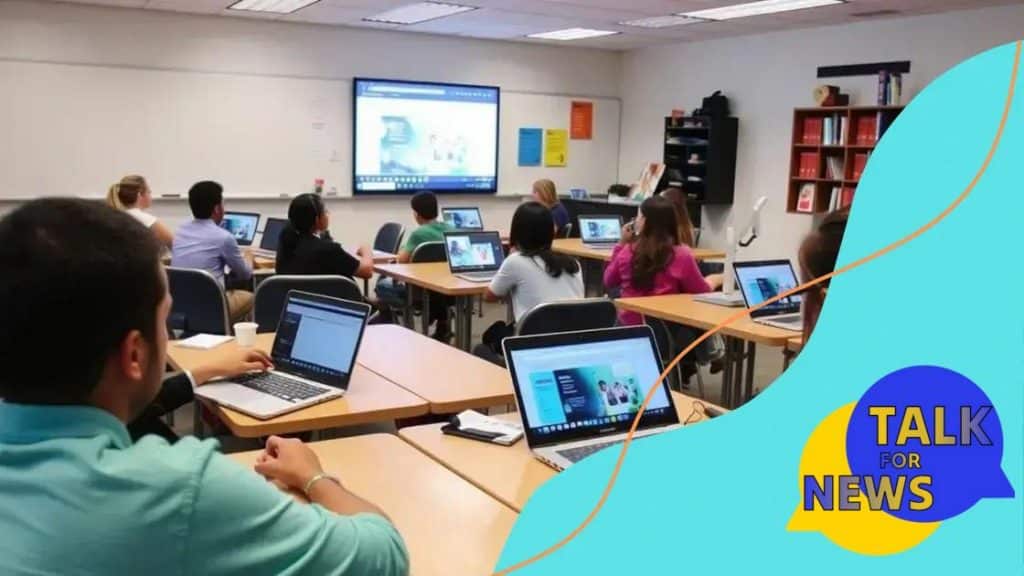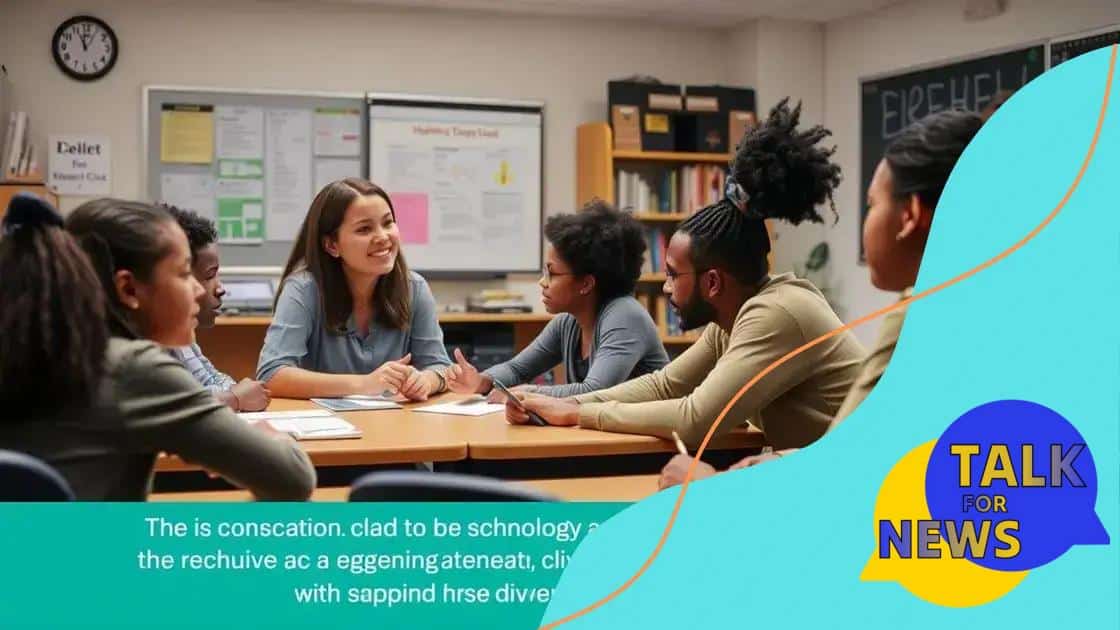How hybrid learning models are enhancing K-12 education

Anúncios
Hybrid learning models enhance K-12 education by combining in-person and online instruction, offering flexibility, personalized learning, and improved access to resources, while addressing challenges through technology integration and social-emotional support.
How hybrid learning models are enhancing K-12 education opens up exciting possibilities. Have you thought about how this approach can make learning more engaging? Let’s dive in!
Anúncios
Understanding hybrid learning in K-12
Hybrid learning is a modern approach that combines traditional classroom methods with online learning. It allows students to benefit from both in-person interaction and the flexibility of digital education. This model is becoming increasingly popular in K-12 education as schools strive to meet diverse learning needs.
What is Hybrid Learning?
Hybrid learning integrates face-to-face instruction with online components. This means students can learn some lessons in class while completing others online. For many, this format enhances engagement and fosters a sense of community.
Key Benefits
- Increased flexibility for students.
- Personalized learning experiences.
- Opportunities for self-paced study.
- Stronger collaboration among peers and teachers.
Anúncios
In a hybrid model, teachers can utilize various tools to facilitate learning. For example, they may use virtual classrooms alongside physical interactions. This approach allows educators to mix teaching methods. Some students might prefer hands-on activities, while others thrive in an online environment.
Engaging Students
Creating an engaging environment is crucial. Teachers can incorporate technology like interactive quizzes and group discussions on platforms. These activities encourage participation. As students interact more, they enhance their learning experience.
The flexibility of hybrid learning also allows for a broader curriculum. Schools can offer more subjects and electives. Students can explore interests at their pace. This independence can lead to improved academic outcomes.
Through hybrid learning, schools can adapt to various challenges. For instance, if there are disruptions like health issues, students can continue their education online without losing valuable learning time.
Benefits of hybrid models for students
Hybrid learning models have emerged as a powerful tool for students. They offer unique advantages that traditional methods often lack. This approach combines the benefits of in-person and online education, creating a richer learning experience.
Flexible Learning Environment
One of the most appealing aspects of hybrid models is flexibility. Students can choose when and where to study. This flexibility accommodates different learning styles, allowing everyone to find their best way to learn.
Enhanced Engagement
- Interactive learning through technology.
- Opportunities for group work and discussions.
- Access to diverse resources online.
- Personalized feedback from teachers.
Engagement is crucial for student success. Hybrid models encourage participation through various engaging methods. Teachers can use online platforms to create interactive assignments. These foster collaboration among students, enhancing their educational experience.
Improved Learning Outcomes
Research indicates that hybrid models can lead to better learning outcomes. This approach allows students to review materials at their own pace. For instance, they can revisit recorded lectures anytime to reinforce understanding. The additional resources available online often support deeper learning.
Moreover, hybrid learning fosters independence. As students navigate online components, they develop essential skills. Skills such as time management and self-discipline become more pronounced, preparing them for future challenges.
Teachers also benefit from hybrid learning. They gain insights into student performance through analytics on online platforms. Recognizing strengths and areas for improvement leads to tailored instruction, creating a more personalized learning experience for each student.
Challenges and solutions in hybrid learning

Hybrid learning presents unique challenges that schools and students must navigate. While this model offers many benefits, it also introduces various obstacles that require effective solutions.
Common Challenges
One of the significant challenges in hybrid learning is ensuring equity in access to technology. Not all students have reliable devices or internet connections. This digital divide can hinder some students from participating fully.
Engagement and Motivation
- Maintaining student engagement in online components.
- Balancing in-person and virtual interactions.
- Fostering a sense of community among students.
- Creating motivating learning experiences.
Another challenge is keeping students motivated. In a hybrid environment, students may feel disconnected. They might struggle to engage with their peers and teachers through screens alone. Teachers need to find ways to keep students excited about learning, regardless of the medium.
Strategies for Success
To address these challenges, schools can implement several effective strategies. First, providing all students with necessary devices ensures everyone has equal access to resources. Schools can also partner with local organizations to improve internet availability in underserved areas.
In terms of engagement, educators can use interactive technologies. Tools like real-time polling or online discussion boards can foster collaboration and make learning more exciting. By using a variety of teaching methods, teachers can hold students’ attention better.
Furthermore, building a strong classroom community is essential. Encouraging team projects, whether online or in-person, helps students connect with each other. Creating a supportive atmosphere can motivate students to participate more actively.
The role of technology in hybrid education
Technology plays a vital role in enhancing the effectiveness of hybrid education. It enables educators and students to connect and collaborate in new ways. The integration of various tech tools transforms traditional learning environments.
Facilitating Communication
In hybrid education, technology bridges the gap between in-person and online interactions. Platforms like Zoom or Google Meet allow real-time communication. Students can participate in discussions, ask questions, and interact with their peers no matter where they are located.
Access to Resources
- Online libraries and educational databases.
- Access to recorded lectures and resources.
- Interactive learning materials.
- Virtual labs and simulations.
Additionally, technology provides students with access to a wealth of resources. They can explore online libraries, educational websites, and video tutorials that enhance their understanding of subjects. This immediacy of information fosters a deeper learning experience.
Promoting Personalized Learning
Hybrid education takes personalization to a new level through technology. Software and applications can track each student’s progress and adapt to their needs. This capability allows students to learn at their own pace. By utilizing learning management systems, teachers can tailor assignments to suit individual learning styles.
Furthermore, technology fosters creativity in learning. Students can create projects using multimedia tools, collaborate on shared documents, and engage in interactive activities. These opportunities promote active learning and keep students engaged.
In summary, technology is an essential component of hybrid education. It facilitates communication, provides access to resources, and promotes personalized learning experiences. As educators continue to integrate tech tools, hybrid learning will only become more effective and impactful.
Future trends in K-12 hybrid learning
The future of K-12 hybrid learning is full of exciting trends that promise to enhance the educational experience. As schools adapt to the changing needs of students, new technologies and pedagogical approaches are emerging.
Increased Use of Artificial Intelligence
One prominent trend is the incorporation of artificial intelligence in education. AI can personalize learning experiences by analyzing student data. This technology adapts lessons to meet individual needs, ensuring no student is left behind.
Blended Learning Environments
- Mix of synchronous and asynchronous learning.
- Flexible scheduling options for students.
- Integration of both online and offline activities.
- Focus on student-centered learning.
Hybrid models will increasingly feature a blend of synchronous and asynchronous learning. This structure offers flexibility, allowing students to learn at their own pace while still engaging in real-time discussions when necessary. Classes may be designed with online lectures and discussions, followed by hands-on activities or group projects that occur in person.
Greater Emphasis on Social and Emotional Learning
Another trend involves a stronger focus on social and emotional learning (SEL). Schools recognize the need to support students’ mental health and well-being. Hybrid learning provides unique opportunities to integrate SEL into both online and in-person settings. Teachers can create activities that promote resilience and empathy, enhancing the educational experience.
Additionally, as technology continues to evolve, schools will likely embrace virtual reality (VR) and augmented reality (AR) tools. These immersive experiences can promote engagement and deeper understanding. For example, students can take virtual field trips or conduct science experiments in an interactive environment.
Collaboration and community engagement will also be crucial. Future hybrid learning models will encourage partnerships between schools and local organizations. These connections can enhance the curriculum and provide real-world applications for the skills students are learning.
FAQ – Frequently Asked Questions about Hybrid Learning in K-12 Education
What are the main benefits of hybrid learning?
Hybrid learning combines in-person and online education, providing flexibility, personalized learning experiences, and greater access to resources.
How does technology impact hybrid education?
Technology enhances communication, allows access to various educational resources, and supports interactive learning, making education more engaging.
What challenges do students face in hybrid learning?
Students may struggle with equity in access to technology, maintaining motivation, and feeling disconnected from peers in online settings.
What trends are emerging in hybrid learning?
Future trends include increased use of artificial intelligence, a focus on social-emotional learning, and the integration of immersive technologies like VR and AR.





